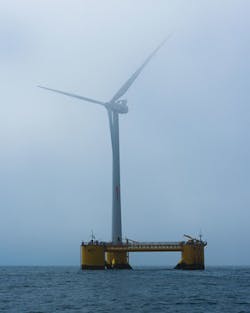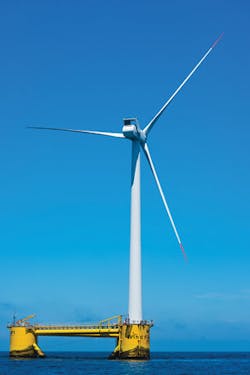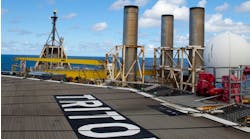Successful prototype inspires follow-on farms offshore Europe
Lars Samuelsson
ABS
Dominique Roddier
Principle Power
Wind energy is playing a prominent role in Europe’s energy mix. The International Energy Agency (IEA) reports that in 2015, the European Union (EU) connected 12.8 gigawatts (GW) of new wind energy capacity, making up 44% of total power capacity installations. According to the report, 30% of new energy generating capacity installed since 2000 has been wind power. The growing number of installations led to a record 279 terawatt hours of electricity of wind-generated energy in 2015, which met more than 9.3% of EU power demand.
The appeal of wind energy
In evaluating alternative energy solutions, the US Office of Energy Efficiency & Renewable Energy lists wind energy as one of the lowest-priced renewable energy technologies available today. Classified as a form of solar energy, wind is a clean and sustainable fuel source. But there are challenges associated with wind energy development, and many of those are compounded when the installations are offshore.
Nearly 10 years ago, Principle Power took on the challenge of developing a floating foundation for offshore wind turbines. At the time, offshore wind installations were bottom-founded, which meant much of the construction work for the structure and installation of the turbine had to take place on-site. This not only added to the safety considerations during construction and installation, but it also added cost, which was a particularly critical concern because it increased the difficulties wind energy faced in competing with traditional energy sources.
Years of development went into creating a new design - a floating foundation for offshore wind turbines. In 2011, ABS reviewed this new design concept, granting official recognition that it complied with the intent of ABS Rules and appropriate codes. The design constitutes the first semisubmersible structure supporting a multi-megawatt wind turbine. Later that year, the first full-scale 2-MW unit was deployed in conjunction with Energias de Portugal (EDP) and other joint venture participants off the coast of Aguçadoura, Portugal. It was installed without the use of any heavy-lift vessels or piling equipment at sea.
ABS supported the local fabrication of the structure in Aveiro and Setubal for around seven months, during which various components of the turbine were assembled, using theABS Rules for Building and Classing Mobile Offshore Drilling Units as a guide. The classification society also issued specific rules, the ABS Guide for Building and Classing Offshore and Wind Turbine Installations, shortly after this project.
This was a milestone in many ways for offshore wind energy development, one of which was the fact that it was the first installation in the Atlantic Ocean. It was executed through the WindPlus joint venture, which included EDP, Principle Power, A. Silva Matos (ASM), Vestas Wind Systems A/S, InovCapital, and Fundo de Apoio à Inovação (FAI), and the support of more than 60 European vendors.
Because this design is not depth-limited, it allows utilities to target the highest quality wind resources found offshore Portugal. The WindFloat has proven its robustness, enduring harsh winter conditions in the open Atlantic and performing well within the predictions anticipated using sophisticated design tools.
Enabling innovations
One of the most significant design differences between the WindFloat and its predecessors is its floating design. The floating foundation introduces a number of advantages. First, its static and dynamic stability provides sufficiently low pitch performance to enable the use of commercial offshore wind turbines. Second, its design and fabrication methodology allow for onshore assembly of the complete system, including the turbine. And third, its shallow draft allows for depth independent siting and wet towing - fully assembled and commissioned - to the installation site. In the initial installation, the offshore tow using simple tug vessels took the unit over approximately 217 mi (350 km) of open waters in the Atlantic Ocean.
Exceptional stability is achieved by patented water entrapment heave plates fitted at the base of each column. The plates “entrain” water, which results in a large added-mass component, and the sharp edges of the plates increase the viscous damping due to vortex shedding. The innovative features of the design dampen wave and turbine induced motion, enabling wind turbines to be sited in previously inaccessible locations where water depth exceeds 130 ft (40 m) and wind resources often are superior.
The patented hull-trim system, also known as active ballast, distributes water ballast among the three columns of the WindFloat to compensate for variable turbine thrust in response to low-frequency changes in wind velocity and direction. This is a closed-loop system, which means no water moves in or out of the system. It is a fail-safe design that uses only a small fraction of the total amount of ballast water, with the process consumption amounting to less than 0.05% of the turbine generation.
Because this design enables the structure to be fully assembled onshore and towed to its final location, it offers significant installation and commissioning advantages. All fabrication and qualification are completed at quayside in a controlled environment before the structure is towed, fully ready for deployment, to the installation site. This is in marked contrast to requirements for installing bottom-fixed foundations, such as monopile or jacket-type structures, which require offshore heavy-lift operations and significant vessel capabilities for installation.
Once the unit reaches the installation site, it is moored using a conventional mooring system. Because no special parts or equipment are required, mooring can be accomplished relatively inexpensively, and there are no restrictions to gaining access to the necessary components. The mooring configuration is similar to those on oil and gas platforms and permanently moored maritime structures. Drag embedment anchors permit installation in various soil conditions, including mud, clay, sand, and layered soils. This type of anchor installation is less weather-dependent than other alternatives, and installation does not require full geotechnical surveys of the seabed prior to design. Further, the incremental cost increase, due to water depth, associated with a WindFloat mooring is minimal. This permits greater flexibility in site location and turbine placement.
Collectively, these innovations could result in reduced operational and maintenance downtime, decreased annual operational costs, and significantly less risk in operations for a windfarm equipped with this type of design.
The next chapter
In June, the five-year testing campaign came to a close with evidence that the WindFloat system, now referred to as WF1, had met or exceeded all design expectations. Over the course of the test, the unit contended with waves exceeding 56 ft (17 m) in height and winds exceeding 60 knots with no evidence of its operational performance being compromised. The WF1 delivered about 17 GW hours of energy to the local grid, providing high levels of availability.
The final stage of the technology demonstration involved system decommissioning, which demonstrated the advantages of the WF1 relative to bottom-fixed offshore wind foundations through reduced decommissioning risk, lower costs, and less environmental impact. These deliverables are made possible by the design, which allows the system to be disconnected from its mooring and returned to port for decommissioning. During operations, the ability to disconnect allows the system to be removed to port for serious maintenance or a large corrective action. During decommissioning, the system was disconnected from its power cable and moorings and towed to a port facility in Portugal, where it underwent a final inspection, the results of which are being used to evaluate possible alternatives for repurposing the unit.
The success and real-world experience of the WF1 have allowed the technology used in this novel design to evolve substantially. Current designs already are under way for multi-unit wind farms with 5-8 MW turbines, and a new project is being funded by a consortium made up of EDP Renewables, Mitsubishi Corp., through its subsidiary Diamond Generating Europe, Chiyoda Corp., through its subsidiary Chiyoda Generating Europe, Engie, and Repsol. These companies have agreed to participate in the WindFloat Atlantic (WFA) project, which will see the installation of a floating offshore wind farm 12 mi (20 km) off the coast of northern Portugal at Viana do Castelo.
Plans are in place for the wind farm - which will consist of three wind turbines on floating foundations, accounting for a total capacity of 25 MW - to be operational in 2019. WFA has European Commission support through the NER 300 program as well as support from the Portuguese government through the Portuguese Carbon Fund. The aim of WFA is to demonstrate the economic potential and reliability of this technology and to advance it on the path toward commercialization. It will be the first non-recourse financed floating offshore wind project in the world, setting the course for the wind industry to flourish.
The future of wind energy
Multiple follow-on projects are under development for the installation of pre-commercial WindFloat units in offshore wind farms in Europe and the US. The objective is to deploy multiple WindFloat systems in an array layout and to test the quick-disconnect operations and maintenance philosophy of the technology.
The next-generation WindFloat systems will make use of learnings from the WF1 prototype deployment and integrate other innovations developed throughout the WindFloat technology development process. Future designs will be optimized in terms of size and performance.
The Renewable Energy Directive that came into force in 2009 sets a target of 20% renewable energy in gross final energy consumption in the EU, which corresponds to 34% of renewables in EU power demand. Meanwhile, European heads of state have set a binding EU-wide renewable energy objective of at least 27% in the context of the 2030 Energy Strategy. At present, the European Commission and other stakeholders are working on several legislative proposals to be presented in 4Q that are likely to affect wind energy development to 2030.
It is clear that expectations for renewable energy are on the table and that legislation is going to be a motivator. Fortunately, there are proven successes for offshore wind energy, and there are projects in place that will further prove its viability.
This and other successes in wind energy development set the stage for more offshore installations and continued investment in wind energy technology.





